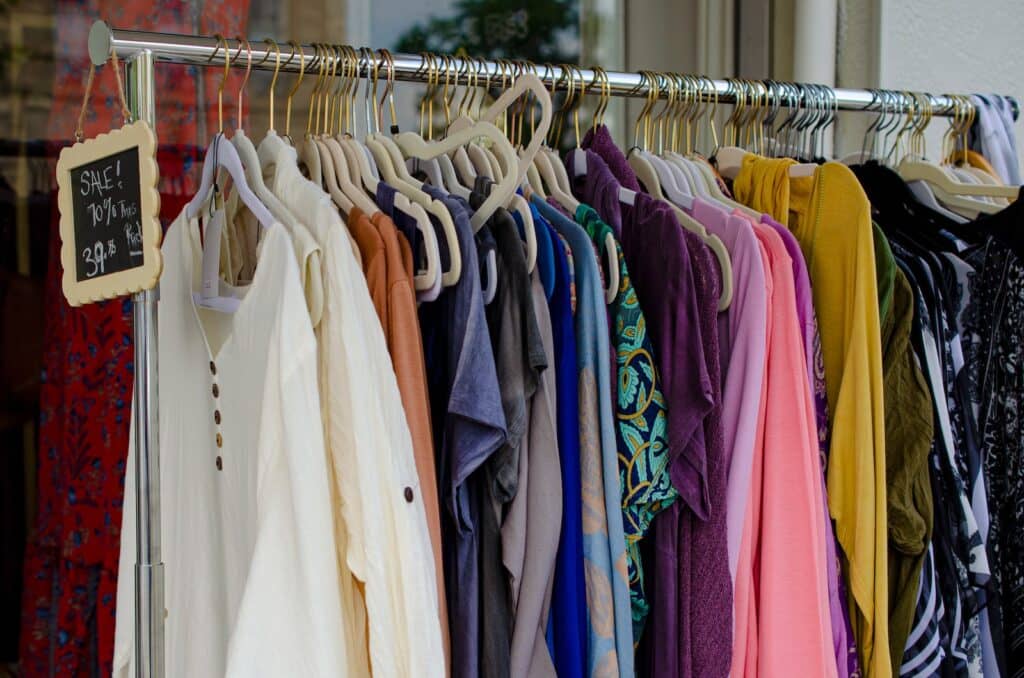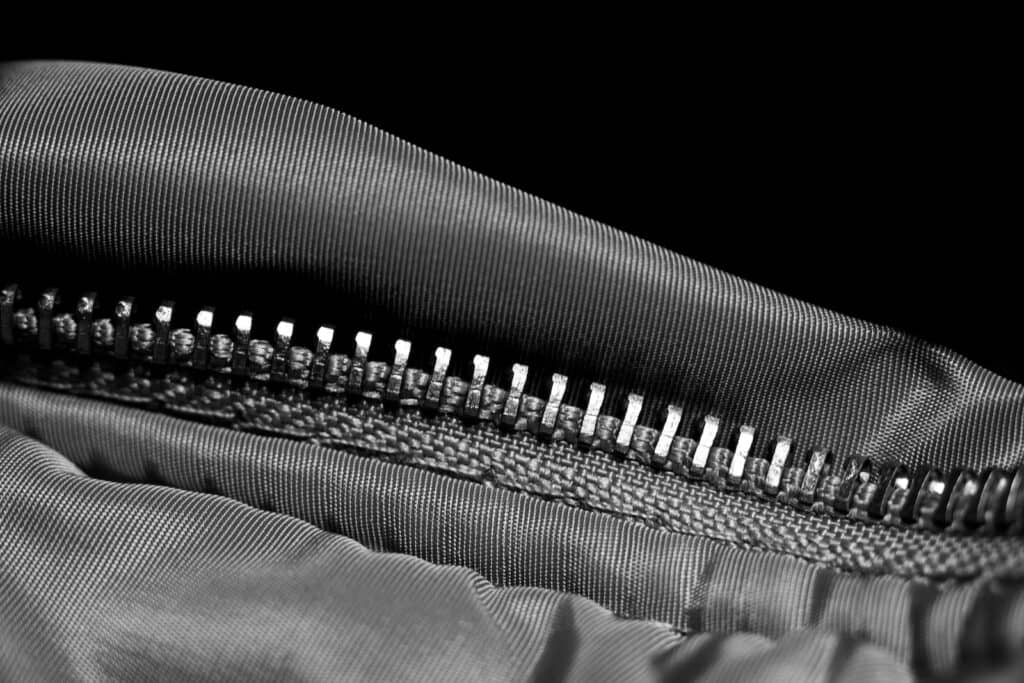Have you avoided buying clothes at the thrift store because you worry about the quality of clothing sold there?
Well, that can certainly be a huge concern in many cases, but we have some helpful tips you can follow to ensure you get high-quality clothing on your next trip to the thrift store.

Continue reading to learn what steps you should take.
10. Check the Country of Origin
As you probably know, clothing today (and most other items, for that matter) is not made with the same quality as clothing from yesteryear due to manufacturers cutting corners to save a few bucks.
So, if you’re looking for clothing of superior quality at a thrift store, your best bet is to buy vintage items. Thankfully, there’s a simple way to distinguish vintage clothing from modern clothing: look at the label to see in what country it was made.
Most vintage garments were made in the U.S. or imported from France, Italy or Hong Kong. That being said, modern clothing will most likely say “Made in China” instead of “Made in Hong Kong.”
9. Know Your Fabrics
High-quality clothing is made with certain fabrics, such as 100% cotton and leather, silk, linen and wool. These are natural fabrics that hold up well after several washes.
On the flip side, there are certain fabrics you should avoid, such as polyester, acrylic, spandex and nylon, which are all synthetic fabrics derived from plastics.
These fibers are more prone to pilling and are easily damaged by heat from drying and ironing. Once you become a pro at it, you won’t even need to look at the tag. You’ll just know which fabrics are high-quality by touch and feel.
8. Get There Early and Go Often
If you get to the thrift store right when it opens, you’ll increase your chances of getting first dibs on the good stuff. On the other hand, show up late, and everything might be all picked over.
The same applies to how often you go. That’s because the merchandise changes daily. So if you only go every now and then, you’ll miss out on some great finds.
“In my heyday, I lived a 5-minute walk from a great thrift store, and I dropped by several times a week. So it’s not a coincidence that I always found tons of awesome stuff there. I created my own luck by showing up all the time”
The Luxe Strategist
7. Hit Up the Independent Stores
Goodwill and the Salvation Army are some of the most popular thrift stores. As a result, things there are likely to be picked over.
That’s why The Luxe Strategist recommends hitting up the independent stores, a.k.a. the “mom and pop” stores. Unfortunately, these stores are usually out of the way for most people, so they don’t ever think about shopping there.
After you hit those up, then you can make your way over to the more well-known stores to see what they have in stock.
6. Look Through Everything
Be thorough when shopping at thrift stores, or else you’ll miss something. And, being thorough also means being patient and putting in enough time to browse the entire store, not just looking at a few things and leaving out of frustration because you didn’t see anything you liked.
On that note, be prepared to spend at least an hour searching through everything in the store. And, if you think it’ll help, bring a friend or two along with you. It certainly won’t hurt to have some extra pairs of eyes and hands.
5. Test Zippers and Snaps

According to an article published by Money Talks News, the number one rule when shopping for secondhand clothing is to test everything twice.
This especially means zippers and snaps. They may look alright but might not work properly. For example, the zippers might not be able to stay on track, or the snaps might not fasten securely.
Something else to keep in mind is the material the zippers are made from. Plastic ones are less durable, more difficult to zip, and easier to pull off the track. That being said, make sure you look for clothing that has metal zippers.
4. Avoid Clothing That Has Been Altered
If clothing has been altered, then that means it has been tailored for a specific body type — and not just that, but for a specific person. While some of us may have the same body type, none of us have the exact same body.
So, you must avoid purchasing any secondhand clothing that has been altered. Unfortunately, some alterations are not noticeable at first glance.
For this reason, you should try any items you plan on buying to “make sure the pant legs haven’t been tapered, sleeves shortened or side seams taken in,” Money Talks News wrote on its website.
3. Look Out for Hanger Bumps
Hanger bumps develop on sweaters and knit shirts that have been on a hanger for too long.
Although you probably feel like you could just iron them out, you should know that there’s a bigger problem at hand than just the appearance of the shirts and sweaters.
Those bumps are an indication that the fabric fibers near the shoulder seam have stretched due to them being on the hanger for so long.
So, do yourself a favor and avoid buying secondhand clothing with hanger bumps. And, when you do buy knit clothing that’s in good condition, fold those items, don’t hang them up.
2. Know Which Sections to Shop and Which Ones to Avoid
According to Verily Magazine, one simple trick to finding quality clothing at the thrift store is to know which sections to shop for and which ones to avoid.
Their advice is as follows: shop the dresses, skirts, button-down shirts, blazers and coats sections, and avoid the pants, t-shirts, sweaters and shoe sections. In other words, your chances of finding quality clothing will be higher if you “focus on sections that have a high success rate.”
For example, it’s easier to find flattering skirts than flattering pants. Also, dresses tend to be more universally flattering. And, used high-end button-down shirts will likely be in good shape.
On the flip side, used sweaters tend to be misshapen and have pilling, and shoes tend to have more wear and tear than other types of clothing.
1. Inspect Seams and Stitching
Inspecting the seams and stitching of secondhand clothing is important if you want high-quality clothing. For one thing, faulty seams can cause wardrobe malfunctions.
On the other hand, even hems and seams improve the drape of the garment. As such, uneven hems and seams are telltale signs that the garment isn’t well made.
Thankfully, there are certain tests you can perform to determine the quality of the seams and stitching:
- Gently pull on each side of a seam. If the stitches hold tight and keep the fabric securely in place, then it’s a quality product.
- Look for stitches that are uniform, straight and reinforced at all stress points, including the armholes of shirts, the edges and corners of pockets, the shoulder area of shirts, the waistband and belt loops, and the crotch and seat of pants.
- Look for seams that lie flat and are free from irregularities like puckers and traveling.
- Gently pull on the side seams of a dress shirt, and hold it up to the light. You should NOT be able to see a lot of light between the stitches. If you can, the quality of the shirt is poor.
Conclusion
Thrift stores can be a great place to find quality clothing at a fraction of the cost of new clothing. To ensure you get high-quality clothing at the thrift store, you can follow a few steps. First, check the country of origin. Most vintage clothing was made in the U.S. or imported from France, Italy or Hong Kong, whereas modern dress is often made in China.
You should also know your fabrics and avoid synthetic materials like polyester, acrylic, spandex and nylon, which are prone to pilling and easily damaged by heat. To increase your chances of finding quality clothing, visit the thrift store early and often, and consider shopping at independent stores rather than well-known chains.
When shopping, thoroughly test everything, including zippers and snaps, and avoid clothing with stains, tears, or strong odours. Finally, consider taking the dress to a tailor to have it altered or repaired if necessary.



